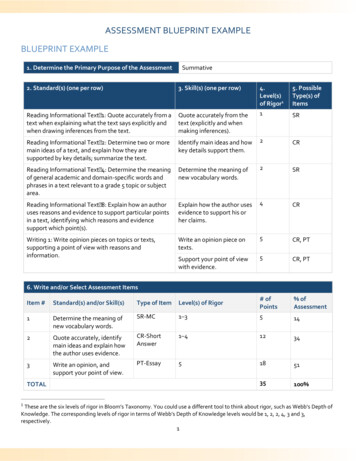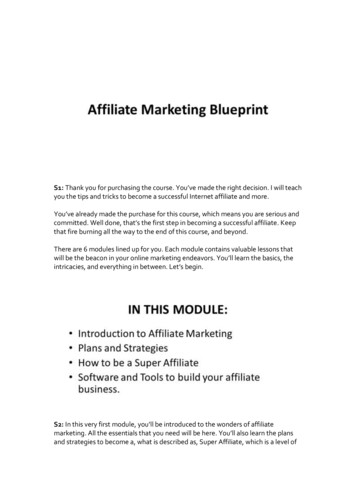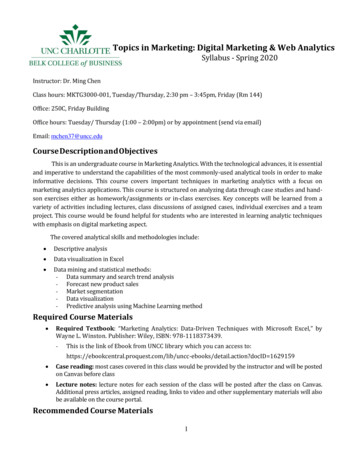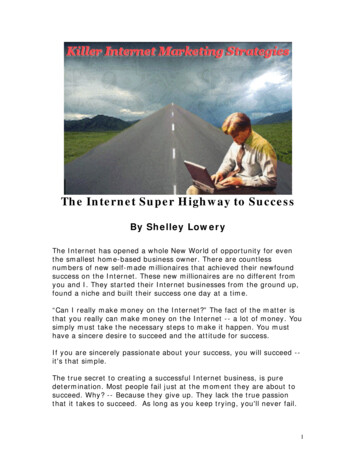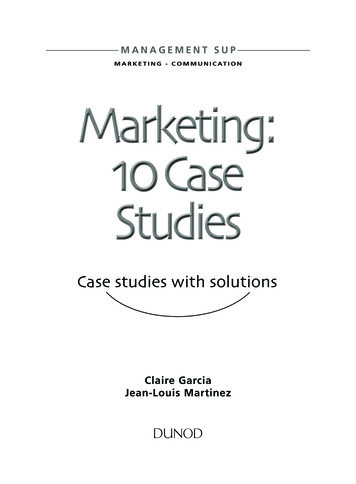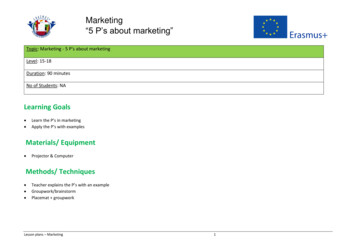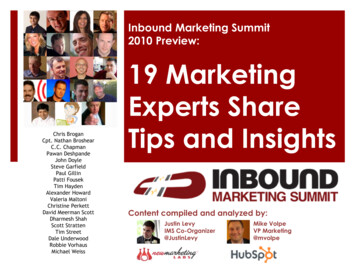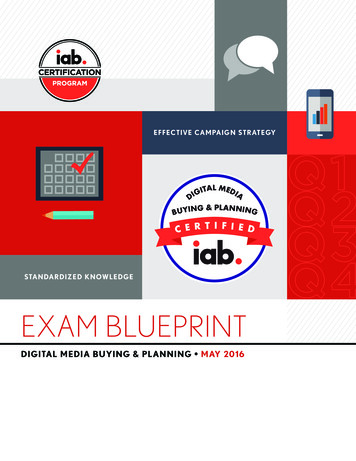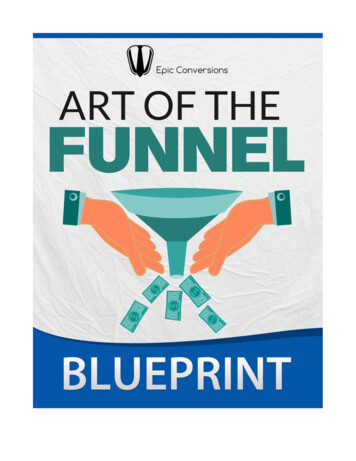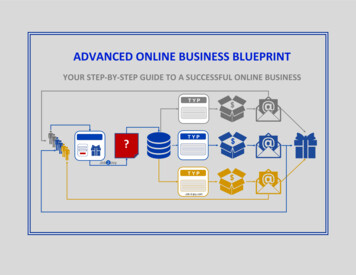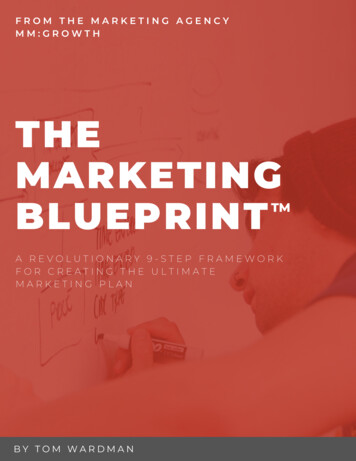
Transcription
FROM THE MARKETING AGENCYMM:GROWTHTHEMARKETINGBLUEPRINTTMA REVOLUTIONARY 9-STEP FRAMEWORKFOR CREATING THE ULTIMATEMARKETING PLANBY TOM WARDMAN
The Marketing BLUEPRINT TM by Tom Wardman. Published by MM:Growth, 16High Petergate, York, YO1 7EH.www.mmgrowth.com 2020 MM:GrowthAll rights reserved. No portion of this book may be reproduced in any formwithout permission from the publisher, except as permitted by U.K. copyrightlaw. For permissions contact:hello@mmgrowth.comCover by Tom Wardman
Table of contentsIntroduction - The need for a marketing plan4The problems you are facing with marketing5Haphazard marketing5Old-school marketing6(You think) you’ve tried it before6“Short-termism”7Who this guide is for8They Ask, You Answer and the Zero Moment of Truth8The impact of the Zero Moment of Truth10Who this guide isn’t for10What is The Marketing BLUEPRINT TM ?12Step 1: Buyer - Why we must become obsessed with our audience13What is a buyer persona?13The difference a buyer persona can make on your marketing14How to create your buyer personas15Do I need negative buyer personas?16Putting it into action16Step 2: Learning - Becoming a teacher and trusted voiceWhy the “Big 5” is all about learning and education18181. Problems192. Comparisons203. “Best of” lists21Best competitors21Best in class21Best practices214. Reviews22Putting it into action22Step 3: Understanding - Educating your audience about your business23Addressing the customer relationship on your website23The importance of discussing price24Putting it into action25Step 4: Engagement - Turning your audience into loyal followersLead capture forms2727Page 2
Marketing automation29Social media30Conversational marketing31Putting it into action31Step 5: Pipeline - Mapping your content to create a funnel of leads33What is a sales funnel?33Top of the Funnel: Awareness35Middle of the Funnel: Evaluation36Bottom of the Funnel: Purchase37Putting it into action38Step 6: Retention - Putting together a marketing and sales funnel39What’s the purpose of repurposing content?39Am I revamping, or repurposing content? What’s the difference?40A step-by-step guide to repurposing your contentPutting it into action4142Step 7: Impact - Creating real human stories that personify your brandThe problem businesses make with storiesPutting it into action434344Step 8: Negatives - Addressing the elephant in the room, “Why wouldn’t theybuy from you?”46The power of disarmament46Putting it into action47Step 9: Time - What work is involved, and what’s next?An easy way to remember the reason you are investing in marketingNext steps and taking actionTM BLUEPRINT 474949Workshop50About the Author52Who are MM:Growth?53Page 3
Introduction - The need for a marketing planCreating a marketing plan can be one of the most daunting tasks youundertake. Whether you are a business owner, or an in-house marketingmanager, it’s important that your inbound marketing strategy addresses allyour marketing efforts.When done right, inbound marketing can be a beast of a machine,generating your business leads and providing a funnel of qualified buyers.The downside however is getting started, and with marketing trendsconstantly evolving, it’s anyone’s guess where you should begin and whatwould be deemed effective.That’s where The Marketing BLUEPRINT TM comes in. All too much have I seenbusinesses struggle with putting a plan together, which is why I created this9-step framework to help you create a solid and deliverable marketing plan.Over the course of this guide, I’m going to cover every step of theBLUEPRINT TM framework, and what each step involves. In short, theframework covers every step you’d naturally need for putting together amarketing plan, from buyer personas, to content calendars, to sales funnelsand everything in between. Each step is fully detailed out, with a summary atthe end to help you put into action everything you’ve learnt.Throughout this guide, I’ll also refer to a number of tools and authors that Ihighly recommend you check out in conjunction with this framework. Thisguide has been written with the clear vision of helping you understand theneed for a marketing plan, and how it can help your business gainmomentum and achieve astronomical results in leads and buyers. Don’t getme wrong, it’s not without a lot of hard work, but it can certainly pay off, andturn your marketing into a money-making machine.At the end of this guide, there’ll be some recommendations for putting thisinto practice. I’m always here to help, and look forward to hearing about yoursuccesses of the back of implementing The Marketing BLUEPRINT TM .Page 4
The problems you are facing with marketingIf you are reading this, then I’m going to assume that you’ve hit a brick wallwhen it comes to your marketing plan. Perhaps your marketing plan isn’tworking effectively, leaving you frustrated with a lack of results.That’s one reason that I encounter when working with businesses on theirmarketing. In fact, there are four main problems that I see businesses facingwhen it comes to their marketing strategy and implementation. So, beforewe look at the BLUEPRINT TM framework, let’s look at each of those in moredetail.As you read through this guide, ask yourself which problem is affecting youthe most, as that will help you apply the BLUEPRINT TM better to your business,and achieve incredible results.Haphazard marketingHaphazard marketing can be defined in many ways. For me, I see it assomeone who takes a “stop and start” approach to their marketing activities.For example, you might post a blog every once in a while for a short period(let’s say six months), and then stop and try Facebook Ads for a few months,before returning to blog writing.This is often referred to as “shiny object syndrome” ( Source: Entrepreneur ),because you could have the very best intentions to commit to bloggingregularly, but as soon as a new and exciting marketing trend pops up, you aredistracted by that and pursue that avenue instead.What’s the issue here? In a word: Consistency. With haphazard marketing,there’s no consistent voice of trust or place of truth created with yourmarketing. It’s difficult to connect your marketing activities together, whichmeans you are not able to track results from what little marketing you havedone so far.Page 5
But it’s even worse for your audience. When there’s no trusted voice createdwith your marketing, what can your audience expect? Confusion? Timewasted? Headaches? They’ll be stuck and overwhelmed, which meansmissed sales opportunities for you and ultimately, wasted marketinginvestment.Old-school marketingYou might look at this point and think “Traditional marketing has beenworking great for us” and I’m not here to dismiss that.Old-school methods like telemarketing and email marketing can still work,but I wholeheartedly believe that they only work best in conjunction withother inbound marketing tactics.So, when businesses come to me and they say they’re struggling withmarketing, it’s often because they’re solely relying on traditional marketingmethods. And the reason this is a problem is similar to the previous problem:A lack of trust.Without regular content, and a maintained website, there’s absolutely notrust building taking place, no authoritative voice building a relationship andhelping your audience make a buying decision.Not only that, but in my experience, businesses who I’ve seen rely ontraditional marketing keep any content focused on them. It’s all gearedtowards promoting them, without any focus on the prospective audience andthey’re pain points. As a result, this can come across very salesy and be a putoff for your audience.(You think) you’ve tried it beforeThis problem follows on from the previous two, and it’s the principle that, bynot fully committing to marketing fully (by that I mean, consistent andregular inbound marketing that builds trust) you’ve not tried it before.Page 6
Not only is it my opinion, but businesses who have implemented inboundmarketing have found it to be by far the most rewarding and influential formof marketing to build trust and brand loyalty. Yet when I meet businesses,they haven’t really attempted it. Either they’ve fallen victim to haphazardmarketing, or they’re bought in solely to traditional marketing methods.But that upside is that if you are in this position, you are starting yourinbound marketing journey on a level playing field, and the marketingBLUEPRINT TM is most definitely going to make a difference.“Short-termism”This final point is one that can be catastrophic for businesses and theirmarketing. Often, when businesses come to me and say: “We triedmarketing. We did this and then that and it just didn’t work” my stockresponse is “Well how long did you try it for?”Almost every time, businesses turn around and say 6 months, sometimeseven less than that. 6 months or less! The problem here is that trust takestime to build with your audience. As we’ll talk about in the next chapter, youraudience is much more savvy and does much more research before making abuying decision. Because of that, if your marketing is not geared to givingadvice and answers, you won’t be able to maintain a relationship of trust.That inability to build trust is made worse with short-termism. Your audiencestill wants helpful content long after they’ve signed up, whether it’seducational material or targeted advice. That relationship still needs to bemaintained, and that simply isn’t possible when businesses give up all toosoon with their marketing.Page 7
Who this guide is forWe’ve already covered the situations and problems you’ve been facing, whichwill be one of the reasons you’ve found the marketing BLUEPRINT TM . But Ialso want to talk about mindset.In order for the BLUEPRINT TM to work, and not just be something you readand never implemented, you have to be in a certain mindset. Primarily, youare the person who wants to take action, and use content and inboundmarketing to become a person of trust.They Ask, You Answer and the Zero Moment of TruthThroughout this guide, I will refer to a book called They Ask, You Answer, byMarcus Sheridan. I recommend that before you proceed any further, youpause and buy yourself a copy. C lick here for the Amazon UK link .They Ask, You Answer has revolutionised how people approach content andinbound marketing. The principle is that you use content marketing toleverage yourself as an authority figure, to build trust, so that your sales teamsdon’t have to “sell”, and instead, your buyers turn up more informed, moreeducated and ready to buy from you.Marcus talks about how important this is for businesses to master their zeromoment of truth, which is the principle that on average, 70% of the buyingdecision is made before a prospect talks to the company. ( Source: Google )Let’s take a step back. With the advent of the internet and many other trends,buyer patterns have taken a monumental shift. If you wanted to buysomething, it used to be that you saw something you liked, went into a storeand bought it off the shelf, and then enjoyed the experience it provided. Forexample: A father might be watching a football game and see a camera advert,thinking: “That looks good. I should buy one.”Page 8
Then he’d go into store, see the packaging, speak to a sales rep to asksome questions, before picking one up off the shelf. After that, he’d go home and enjoy taking lots of pictures and theexperience it provides him and his family, just as advertised.Now however, there’s an extra step, and that step is research , which is whathas become known as the z ero moment of truth.Fig 1: The Zero Moment of Truth ( Source: Google )In other words, before a consumer gets in touch with your business, they willhave done a mass amount of research and made a significant portion of theirbuying decision.To use the earlier example, now the father might see the camera advert, butnow he grabs his laptop and looks at reviews, social media posts, videos,demos and more before he gets to the store shelf. In other words, he’sjudging a company online before he makes a decision offline.Page 9
This is the zero moment of truth. In fact, research has shown that buyerswill consume on average 10 pieces of content before they purchase froma company. ( Source: Trustpilot )The impact of the Zero Moment of TruthBecause of this massive shift in buyer behaviour, no longer is it possible forsales and marketing teams to work in isolation. Originally, you had eachdepartment working in it’s own silos, marketing responsible for growing thebrand, and sales responsible for driving revenue.But instead, marketing can have a much greater impact on the actual sale,because it’s now your marketing’s responsibility to be answering questions,to build trust and to influence the buying decision. Sales only accentuatesthat, with marketing content working in tandem with your sales team andprocesses.No longer is there a divide between sales and marketing, and that line willonly continue to blur over time. Who knows, in the next decade, it might be80%, 90% or even 100% of the buying decision made before a consumer getsin touch. In other words, if you’re not publishing content consistently online,in the eyes of your consumers, you don’t exist!So, when I talk about the mindset needed for the marketing BLUEPRINT TM towork, I’m talking about the mindset of embracing the principles of They Ask,You Answer and the Zero Moment of Truth, and being prepared to usemarketing, in the long-term, for building trust and relationships with youraudience.If that’s you, then keep reading!Who this guide isn’t forBy the same token, I think it’s important to talk about who this guide isn’t for.Essentially, this guide won’t work for you if you want a quick fix, or if you planon burying your head in the sand and do nothing.Page 10
Marketing is about taking action and a long-term commitment to servingyour audience with helpful content that
BLUEPRINT TM framework, and what each step involves. In short, the framework covers every step you’d naturally need for putting together a marketing plan, from buyer personas, to content calendars, to sales funnels and everything in between. Each step is fully detailed out, with a summary at
